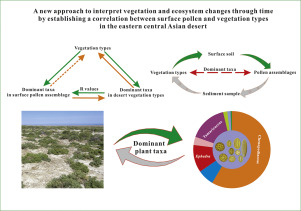当前位置:
X-MOL 学术
›
Palaeogeogr. Palaeoclimatol. Palaeoecol.
›
论文详情
Our official English website, www.x-mol.net, welcomes your feedback! (Note: you will need to create a separate account there.)
A new approach to interpret vegetation and ecosystem changes through time by establishing a correlation between surface pollen and vegetation types in the eastern central Asian desert
Palaeogeography, Palaeoclimatology, Palaeoecology ( IF 3 ) Pub Date : 2020-08-01 , DOI: 10.1016/j.palaeo.2020.109762 Kai-Qing Lu , Feng Qin , Yang Li , Gan Xie , Jin-Feng Li , Yi-Ming Cui , David K. Ferguson , Yi-Feng Yao , Guo-Hong Wang , Yu-Fei Wang
Palaeogeography, Palaeoclimatology, Palaeoecology ( IF 3 ) Pub Date : 2020-08-01 , DOI: 10.1016/j.palaeo.2020.109762 Kai-Qing Lu , Feng Qin , Yang Li , Gan Xie , Jin-Feng Li , Yi-Ming Cui , David K. Ferguson , Yi-Feng Yao , Guo-Hong Wang , Yu-Fei Wang

|
Abstract The temperate desert in arid central Asia (ACA) is located along the Silk Road, an ancient land route used for economic and cultural exchange between the East and the West. In this paper, we survey of 145 surface pollen samples and related modern vegetation sample plots along an east-west desert transect in the eastern ACA in order to relate surface pollen assemblages to specific desert vegetation types. Results reveal that (1) the surface pollen assemblages reflect the modern vegetation composition in terms of dominant taxa, (2) three zonal vegetation belts are recognizable by the surface pollen assemblages, and even the six desert vegetation types with mosaic distribution are also distinct, and (3) the ratio of Chenopodiaceae and Artemisia provides no resolution in further identifying the different desert vegetation types. These findings allow us to develop a new approach for reconstructing past vegetation succession and desert ecosystem formation. Applying these calibrate ancient datasets to palaeoecologic analysis offers a method to improve the resolution at which different desert vegetation types can be distinguished and to more precisely understand the composition of desert ecosystems. The new approach is, not only, applicable to the Quaternary, but also to Neogene whose taxa are almost the same at the genus and/or family level.
中文翻译:

通过建立中亚东部沙漠地表花粉和植被类型之间的相关性来解释植被和生态系统随时间变化的新方法
摘要 中亚干旱温带沙漠(ACA)位于丝绸之路沿线,是东西方经济文化交流的古老陆路。在本文中,我们调查了 145 个地表花粉样本和相关的现代植被样地,沿着 ACA 东部的东西沙漠横断面,以将地表花粉组合与特定的沙漠植被类型联系起来。结果表明:(1)地表花粉组合在优势类群上反映了现代植被组成;(2)地表花粉组合可识别出3个带状植被带,甚至6种镶嵌分布的荒漠植被类型也各不相同, (3)藜科与艾蒿的比例无法进一步识别不同的荒漠植被类型。这些发现使我们能够开发一种新方法来重建过去的植被演替和沙漠生态系统的形成。将这些校准的古代数据集应用于古生态分析提供了一种方法,可以提高区分不同沙漠植被类型的分辨率,并更准确地了解沙漠生态系统的组成。新方法不仅适用于第四纪,而且适用于新近纪,其分类群在属和/或科水平上几乎相同。将这些校准的古代数据集应用于古生态分析提供了一种方法,可以提高区分不同沙漠植被类型的分辨率,并更准确地了解沙漠生态系统的组成。新方法不仅适用于第四纪,而且适用于新近纪,其分类群在属和/或科水平上几乎相同。将这些校准的古代数据集应用于古生态分析提供了一种方法,可以提高区分不同沙漠植被类型的分辨率,并更准确地了解沙漠生态系统的组成。新方法不仅适用于第四纪,而且适用于新近纪,其分类群在属和/或科水平上几乎相同。
更新日期:2020-08-01
中文翻译:

通过建立中亚东部沙漠地表花粉和植被类型之间的相关性来解释植被和生态系统随时间变化的新方法
摘要 中亚干旱温带沙漠(ACA)位于丝绸之路沿线,是东西方经济文化交流的古老陆路。在本文中,我们调查了 145 个地表花粉样本和相关的现代植被样地,沿着 ACA 东部的东西沙漠横断面,以将地表花粉组合与特定的沙漠植被类型联系起来。结果表明:(1)地表花粉组合在优势类群上反映了现代植被组成;(2)地表花粉组合可识别出3个带状植被带,甚至6种镶嵌分布的荒漠植被类型也各不相同, (3)藜科与艾蒿的比例无法进一步识别不同的荒漠植被类型。这些发现使我们能够开发一种新方法来重建过去的植被演替和沙漠生态系统的形成。将这些校准的古代数据集应用于古生态分析提供了一种方法,可以提高区分不同沙漠植被类型的分辨率,并更准确地了解沙漠生态系统的组成。新方法不仅适用于第四纪,而且适用于新近纪,其分类群在属和/或科水平上几乎相同。将这些校准的古代数据集应用于古生态分析提供了一种方法,可以提高区分不同沙漠植被类型的分辨率,并更准确地了解沙漠生态系统的组成。新方法不仅适用于第四纪,而且适用于新近纪,其分类群在属和/或科水平上几乎相同。将这些校准的古代数据集应用于古生态分析提供了一种方法,可以提高区分不同沙漠植被类型的分辨率,并更准确地了解沙漠生态系统的组成。新方法不仅适用于第四纪,而且适用于新近纪,其分类群在属和/或科水平上几乎相同。



























 京公网安备 11010802027423号
京公网安备 11010802027423号